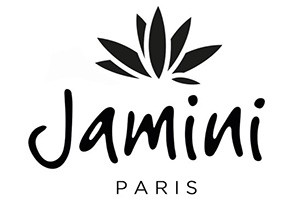Anumitra, une cheffe expressément pétillante

Anumitra, une cheffe expressément pétillante
Quoi de mieux pour célébrer l'ouverture de notre restaurant éphémère que de vous présenter la cheffe indienne Anumitra Ghosh Dastidar, reconnue pour son travail de précision et de quête du goût autour des ingrédients « simples ».
Issue du Nord-Est de l’Inde avec quelques racines Bengales, elle a toujours été fascinée par les histoires que lui racontait sa grand-mère étant plus jeune et elle souhaite sublimer ses origines dans tous les plats qu’elle réalise. Sa cuisine se traduit par son envie de créer une connexion délicate entre toutes les saveurs pour qu’elles puissent être en osmose et fusionner dans nos papilles.
En plus de son don de gastronome, Anumitra possède un doctorat en linguistique cognitive, ce qui lui a permis de comprendre davantage le langage utilisé par les ingrédients pour être en harmonie dans un plat. Nous sommes admiratives de cette cheffe exceptionnelle qui, par sa personnalité pétillante, se donne tous les moyens de réussir. Être une cheffe dans un pays avec une société patriacarle est un défi qu’Anumitra doit relever tous les jours. Elle n’a pas hésité à se battre pour défendre les valeurs de sa cuisine et vivre librement de sa passion.
Nous sommes très fières de pouvoir vous présenter cette merveilleuse cheffe qui saura vous faire voyager à travers une promenade gustative inoubliable lors de l’ouverture du Kaziranga Express.
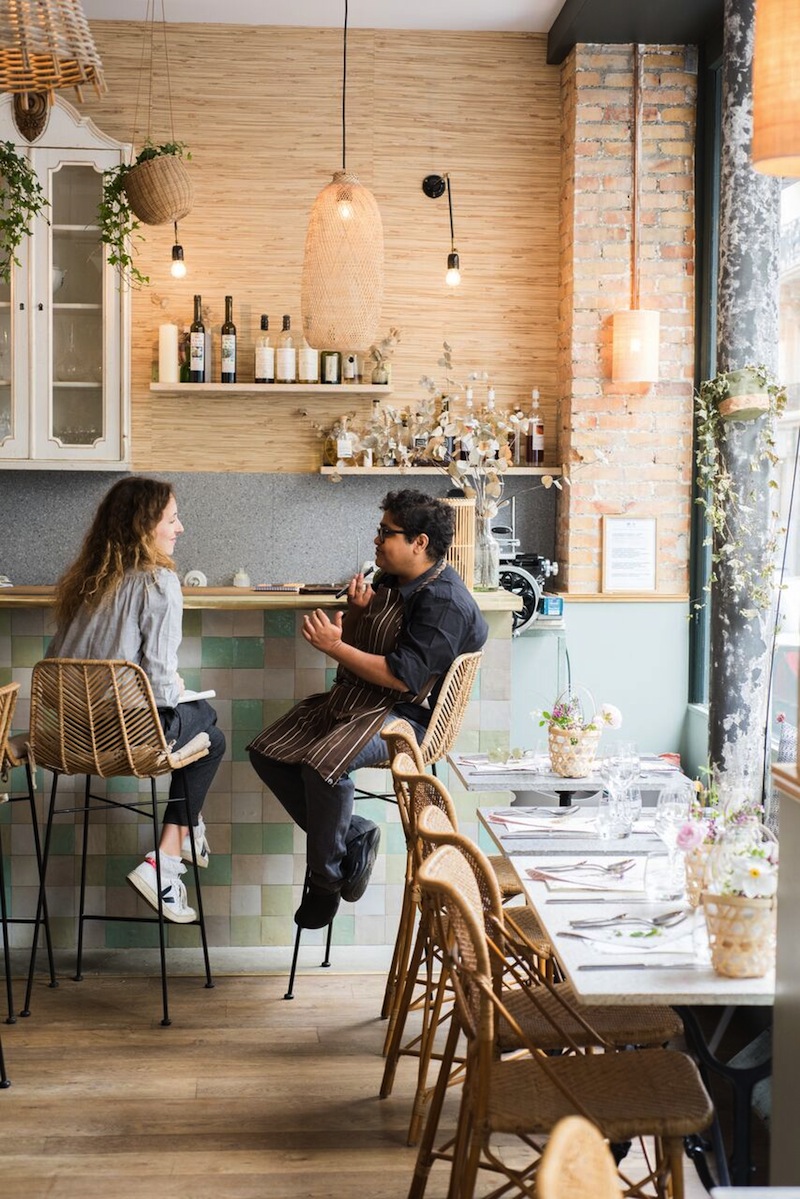
© Géraldine Martens
1. Comment votre amour pour la cuisine a-t-il débuté ?
J’ai toujours été attirée par la nourriture et les différents aspects visuels des ingrédients. En grandissant, j’ai passé beaucoup de temps avec ma mère et mes grands-mères, qui sont toutes d’excellentes cuisinières. Lorsqu’elles faisaient la cuisine, je dessinais les ingrédients qu’elles utilisaient. Ma grand-mère aimait que ses plats soient légers alors nous allions chercher des légumes frais dans le jardin pour créer des menus spécialement pour elle. J’adorais faire ça !
2. Parlez-nous de votre famille; comment ont-ils réagi lorsque vous leur avez annoncé votre rêve de devenir cheffe ?
Dans ma famille tout le monde est un fin gourmet ! Cependant, l’idée que leur fille soit cheffe n’avait jamais été attrayante pour quiconque. Ils auraient préféré que je sois médecin ou professeur. En effet, avoir une fille qui rêve de devenir cheffe était difficilement acceptable dans la famille, c’est pourquoi j’ai décidé de ne pas leur en parler. Parfois, lorsque je mentionnais que j’avais envie de devenir cheffe, personne ne semblait intéressé par le sujet. Alors j’ai poursuivi mon cursus universitaire et j’ai validé mon doctorat. Dotée d’un diplôme solide, j’ai enfin décidé d’entrer dans le monde professionnel de la cuisine.
3. Quels sont les challenges auxquels vous avez dû faire face en Inde en tant que femme dans le monde très masculin de l’industrie gastronomique ?
C’est un défi permanent de faire ses preuves. Les collègues masculins m’ont rarement considéré comme faisant partie de la même équipe ou m’ont rarement prise au sérieux. Parfois, ils me proposaient de m’aider pensant que je n’étais pas suffisamment forte pour porter mes propres ustensiles de cuisine, mais souvent la personne qui me proposait ça était elle-même menue et petite ! J’ai l’habitude de l’effort physique et de soulever des objets lourds, mais j’ai du mal à convaincre les gens de ma force.
J’ai travaillé quelques années dans un restaurant appelé Diva et j’avais une super boss. C’était une femme très douce. J’ai aussi eu la chance d’être formée par un chef japonais au début de ma carrière et ça lui était égal de savoir si j’étais une femme ou un homme. C’était une personne incroyable avec qui travailler. Il souhaitait simplement transmettre son savoir et son expérience, et il appréciait beaucoup ma curiosité.
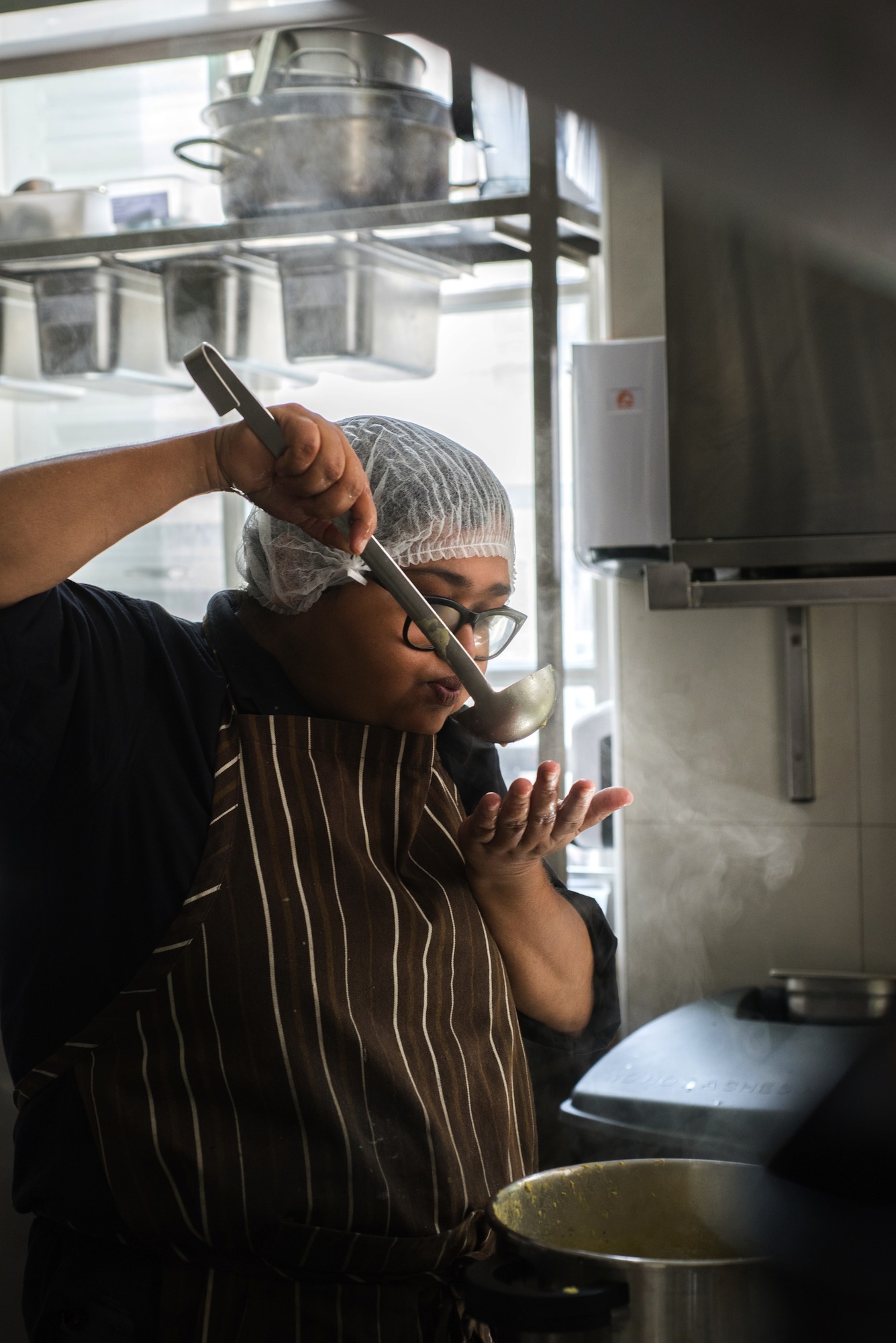
© Géraldine Martens
4. Possédez-vous votre propre restaurant ?
Quels sont les projets culinaires intéressants pour lesquels vous avez travaillé ? Ma carrière a débuté dans un restaurant japonais à Delhi. Après quelques années, j’ai ouvert mon propre restaurant nommé « Big Bong Theory ». Bong est le nom commun utilisé pour désigner les « Bengale » en Inde. Je voulais présenter la cuisine bengalie dans un restaurant où la structure est davantage professionnelle.
Mon expérience suivante fut chez Diva, un charmant restaurant italien dans la ville de Delhi. Nous travaillions sur une interprétation plus moderne de la cuisine italienne traditionnelle. C’était une période où je voyageais beaucoup en Asie de l’Est, notamment au Japon et en Chine. Quelques mois après, j’ai réalisé que mes racines du Bangladesh me manquaient. Alors j’ai décidé de quitter mon travail chez Diva pour me focaliser davantage sur un fabuleux projet qu’est la biennale de Kochi, la plus importante exposition d'art Indien sur trois mois.
Mon projet à la biennale était axé sur des plats faits maison provenant de toute l’Inde. J'ai créé des menus de régions aussi variées que Kashmir au nord et Manipur à l'extrême est. J'ai passé de bons moments à expérimenter avec plusieurs autres chefs et à associer du riz du nord de l'Inde à une cuisine du sud en créant des menus assez inventifs. Pendant 108 jours, j’ai dû créer 108 menus différents, ça a été un défi énorme mais j’ai aimé chaque instant.
Inspirée et motivée par certaines discussions, j’ai débuté par la suite un projet intitulé Edible Archives. J’ai parcouru l’Inde pour collecter et archiver différentes variétés de riz indigène. Plusieurs de ces variétés ne sont pas commercialisées; la plupart du temps, les fermiers cultivent le riz pour leur consommation personnelle. Beaucoup de ces variétés sont en danger car l’industrialisation rapide a eu un impact négatif dans l’agriculture et les petites fermes d’Inde.
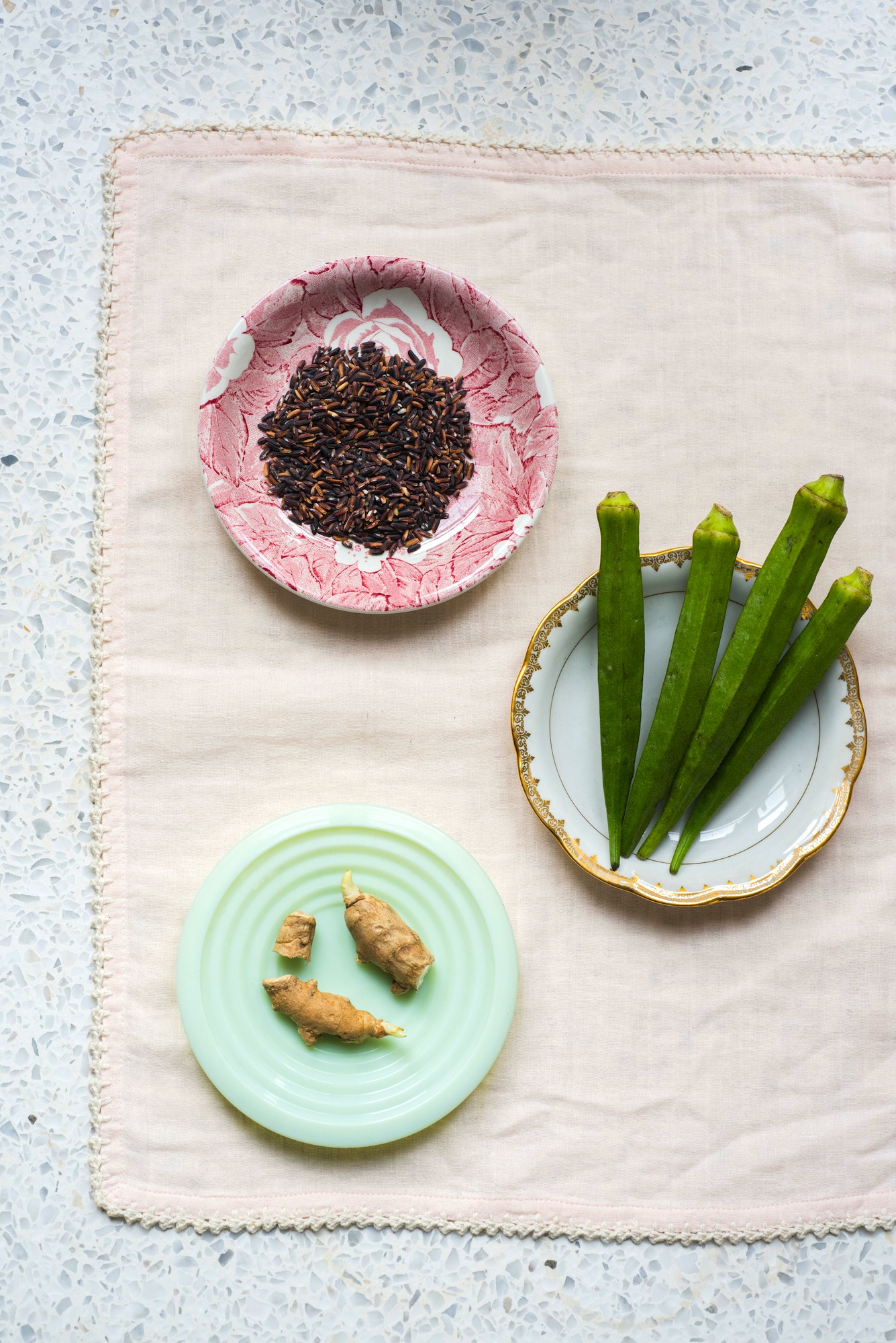
Saurez-vous reconnaître ces ingrédients ?
© Géraldine Martens
5. Parlez-nous de votre expérience de voyage culinaire préférée et comment cela a influencé votre carrière.
C’est une question difficile ! Je voyage énormément et la plupart du temps ces voyages sont en lien avec la cuisine. En premier, je pourrais citer mon voyage en Thaïlande, qui m’a profondément marqué, suivi ensuite de celui du Japon. En Thaïlande, j’ai travaillé avec un chef thaï dont la mission était de populariser la cuisine traditionnelle thaïlandaise et la manière dont la cuisine thaï était consommée dans les villages. Il me faisait vivre un enfer au début mais travailler avec lui m’a permis de faire une réelle introspection sur moi-même et m’a marquée à vie. Par exemple, je me souviens du jour où il a placé devant moi trois variétés de noix de coco en me demandant de goûter l’eau de chacune d’elles et de lui dire quelle variété avait poussé près d’un canal, près de la mer ou près d’une rivière ! Il m’a fait comprendre comment ces éléments pouvaient avoir un impact sur les goûts de nos aliments et cela a complètement changé ma vision des choses.
J’ai appris qu’avec la nourriture il n’était pas vraiment question de bon ou de mauvais goût, mais plutôt de la façon qu’elle a de nous toucher et de nous faire penser. Cela m’a appris à comprendre et à regarder mes projets différemment. Quand je suis en cuisine, il n’est pas question uniquement de la tâche que j’effectue mais plutôt de la connexion qui se crée au plus profond de moi-même.
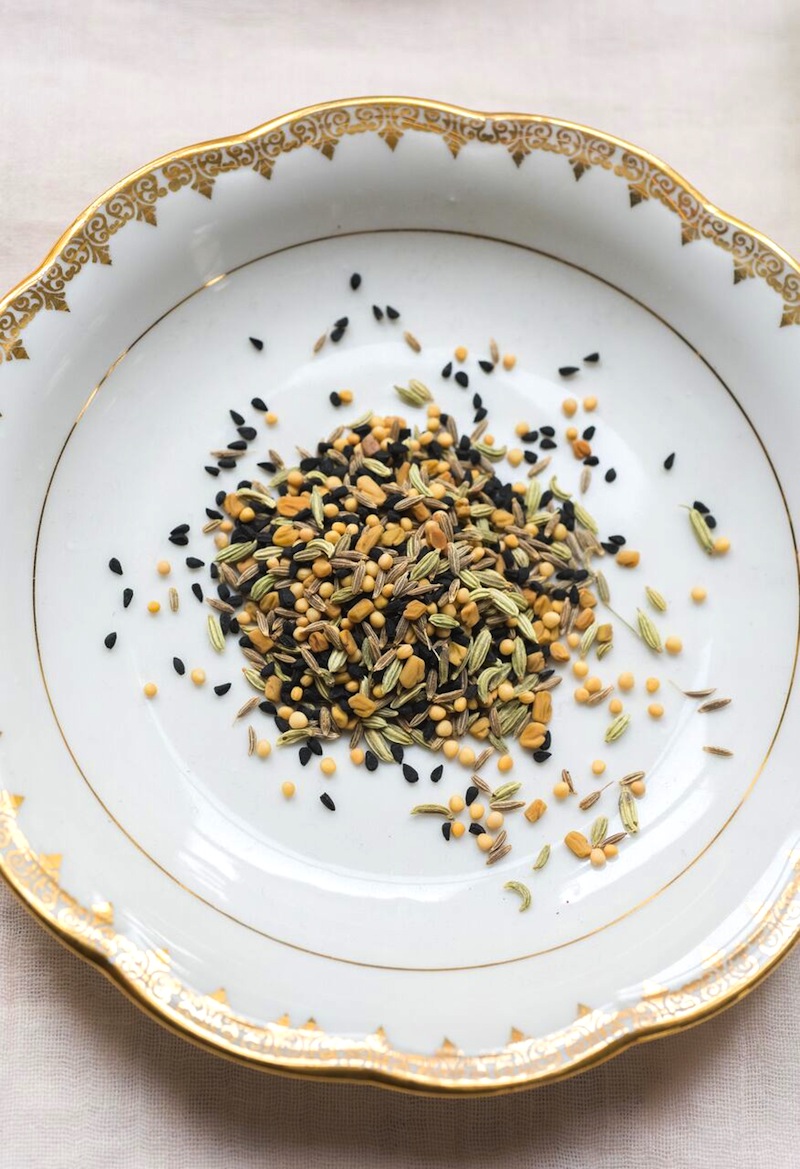
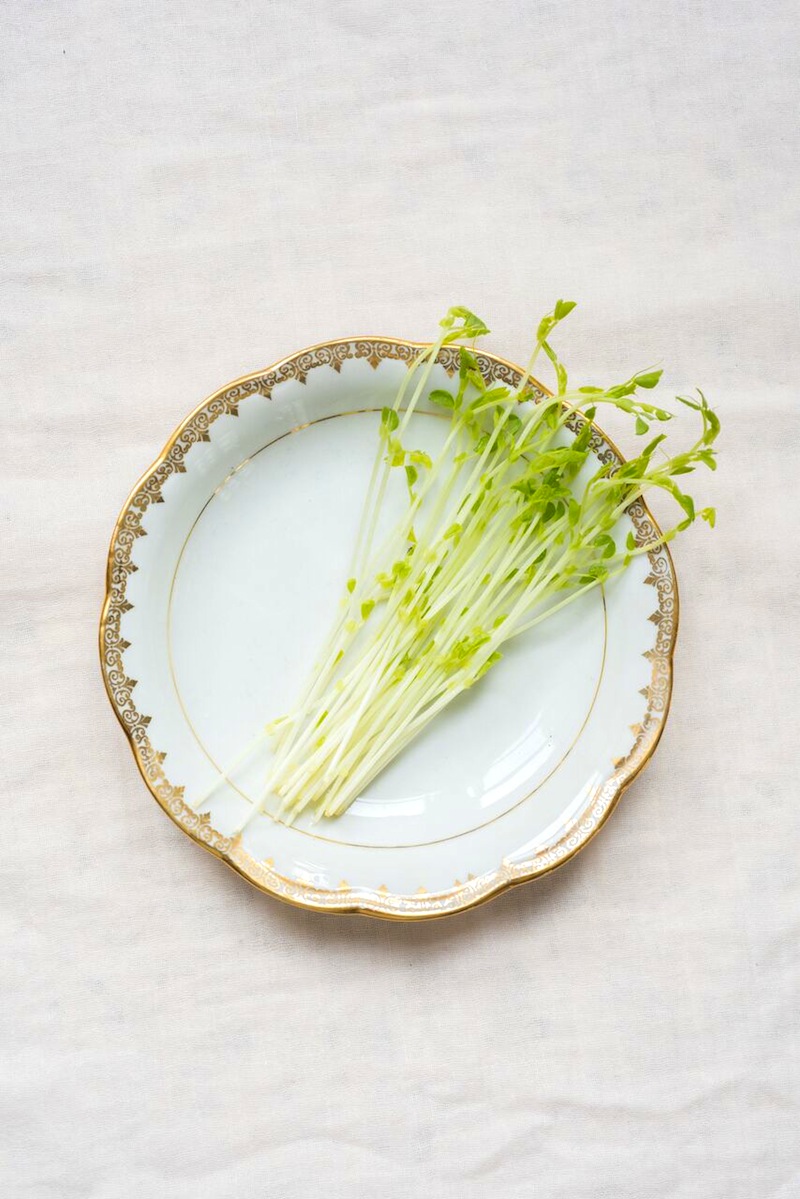
Ces condiments mystères donneront un coup de fouet à vos plats !
© Géraldine Martens
6. Comment définiriez-vous votre style de cuisine ?
Mon style culinaire évolue constamment ! J’ai travaillé différents types de cuisine : italien, thaï, japonais, chinois, un peu mexicain et vietnamien ainsi que différents types de cuisine régionale indienne. Aujourd’hui, j’ai choisi de revenir à mes racines et d’expérimenter la cuisine de l’Est de l’Inde.
Je porte beaucoup d’importance aux détails ainsi qu’à l’origine des ingrédients, en essayant de trouver des producteurs d’agriculture biologique et en racontant d’où ils proviennent. Je suis moins intéressée par le type de cuisine mais plutôt par l’innovation et la combinaison de différents ingrédients dans une démarche responsable.
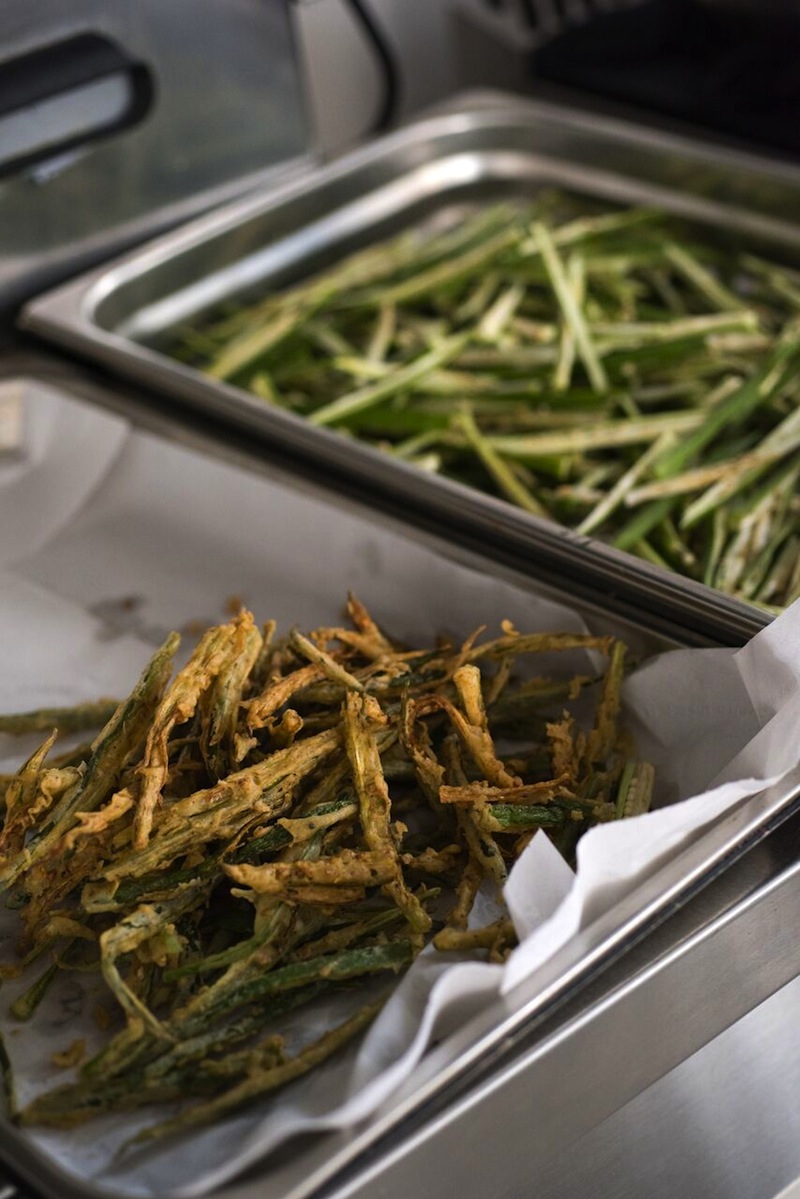
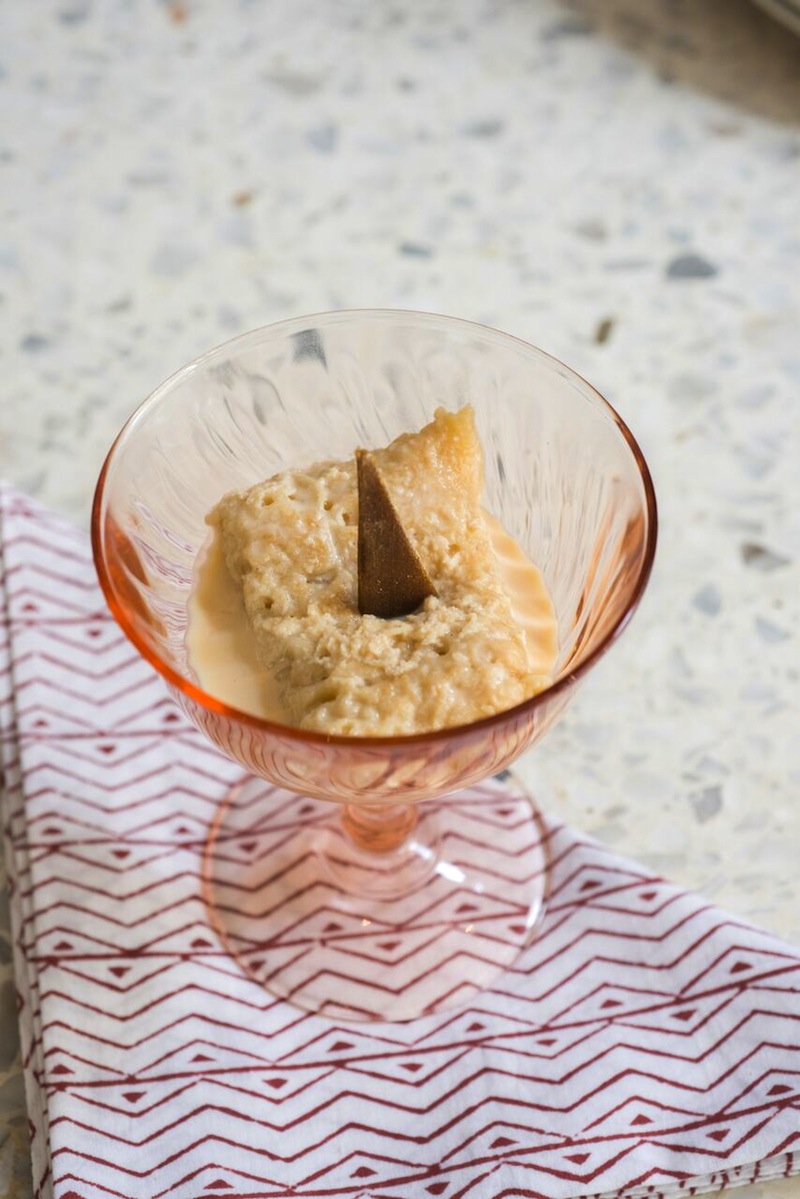
De haut en bas : de délicieux gombos frits - le "Peethé", une douceur sucrée
© Géraldine Martens
7. Comment définiriez-vous la cuisine du Nord-Est de l’Inde, qui est relativement différente et moins connue que la cuisine du Nord ou du Sud du pays ?
La cuisine du Nord-Est de l’Inde est très différente du reste du pays et relativement moins connue. En tant que linguiste, je pense qu’il existe des similitudes entre les différents langages d’Inde et les différentes variétés de cuisines. Par exemple, la cuisine du Nord de l’Inde présente des similitudes avec la cuisine de l’Afghanistan ou du Pakistan parce que ces pays sont proches en termes d’emplacement géographique, sans pour autant être connectés au niveau politique.
La cuisine du Nord-Est de l’Inde, de la même manière, présentera plutôt des similitudes gustatives avec les cuisines birmanes et thaïlandaises en raison de leur proximité géographique, une cuisine bien différente de celle du Nord alors que ces régions sont politiquement reliées. Plus nous allons à l’Est, plus les aliments sont « lights ». Les terrains deviennent plus hostiles, les ingrédients se font plus rares et cela se ressent dans la cuisine.
L’Assam étant géographiquement plus varié, il y a plus d’ingrédients que ce que l’on trouve habituellement dans le reste de l’Inde, ainsi que ceux que nous avons l’habitude de trouver en Thaïlande ou en Birmanie. Les repas sont composés de riz, de lentilles et de légumes avec une structure similaire à ceux d’autres régions d’Inde mais les ingrédients vont être complètement différents.
8. Comment avez-vous élaboré le menu pour Kaziranga Express ?
Deux facteurs importants m’ont influencé lorsque j’ai commencé à travailler sur le projet du Kaziranga Express. Tout d’abord mon expérience à l’Université de Chicago, où j’ai eu la chance de faire découvrir la cuisine du Nord-Est de l’Inde à un groupe de personnes qui n’avait jamais goûté ce style de cuisine auparavant et ensuite mon projet « Edible Archives » qui était axé sur les différentes variétés de riz. J’ai énormément voyagé afin de créer un menu intéressant pour le premier projet, testant différents plats et ingrédients à travers toute l’Inde, que j’ai pu intégrer au menu Kaziranga Express.
J’ai aussi eu la chance de découvrir d’incroyables variétés de riz comme le riz rose de Mysore, le riz préféré de la famille royale, que j’ai choisi d’inclure au menu. Mes origines Bengale se retrouvent également dans la carte.
9. Quels aspects de la cuisine française vous inspire le plus ?
J’adore comment la cuisine française donne une place primordiale dans les ingrédients sélectionnés ! Même quelque chose comme la sauce soja est utilisé de manière innovante et créative pour donner une touche française.
J’admire aussi la manière dont les Français sont connectés à la nourriture, en étant curieux et en voulant comprendre d’où proviennent les aliments qui se trouvent dans leurs assiettes. J’apprécie également la valeur qui est donnée aux productions locales et biologiques très courantes en France. Mais ce que j’aime par-dessus tout, c’est ce point commun qu’il y a entre la cuisine française et la cuisine indienne du Nord-Est : la moutarde bien sûr !
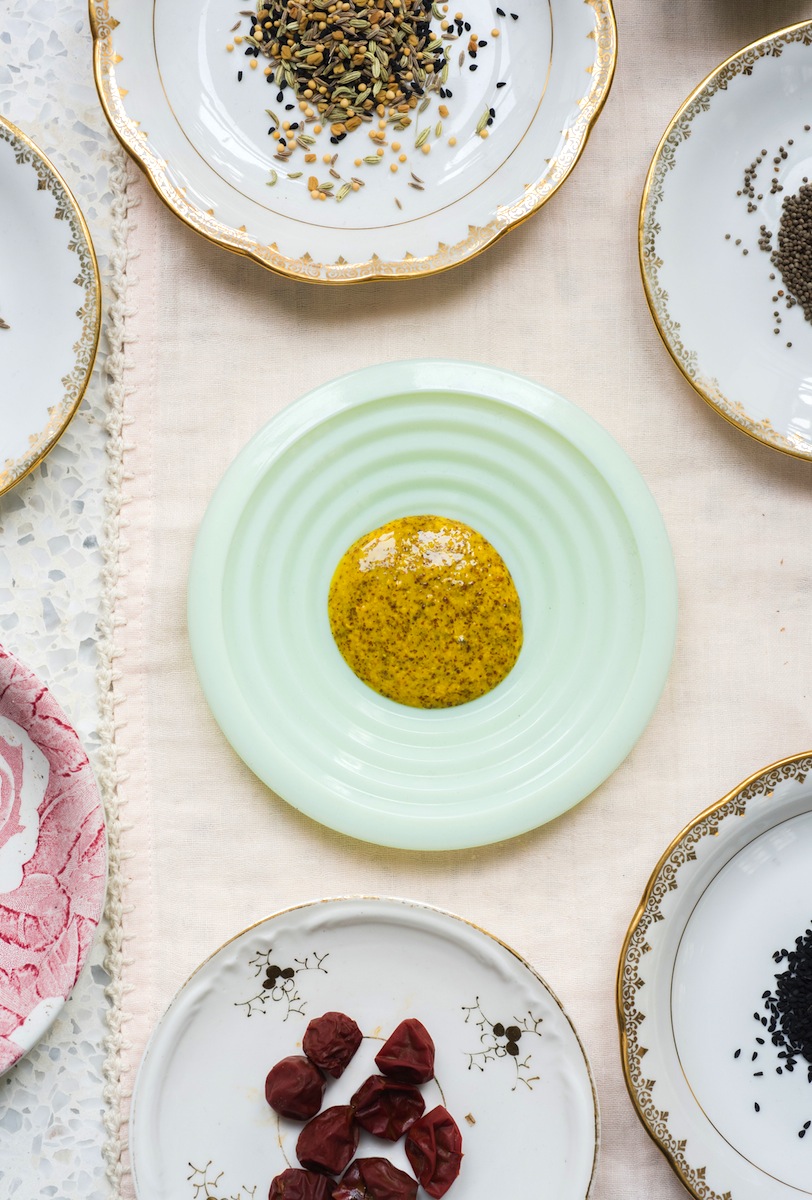
© Géraldine Martens
10. Comment voyez-vous votre travail en rapport avec les valeurs de Jamini ?
Avec Usha nous partageons la même vision. Nos origines et nos identités culturelles façonnent notre travail. Lorsque je parle d’ingrédients, Usha valorise l’artisanat traditionnel de nos communautés. Nous créons peut-être des produits différents mais notre approche de ce qui « fait » le produit est assez similaire. J’apprécie énormément l’univers Jamini et l’esthétique de ses produits qui en font une marque hors du commun.
L'équipe de choc !
© Géraldine Martens
